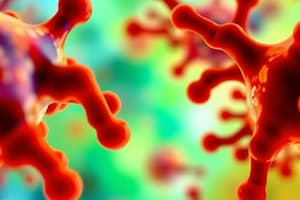Podcast
Questions and Answers
What is adrenaline?
What is adrenaline?
Often very rapid, lasts for a short period.
What is diffusion?
What is diffusion?
When particles move from a region of higher concentration to a lower concentration as a result of their random movement until equilibrium is met.
Types of neurones include __________.
Types of neurones include __________.
Motor neurones, Sensory neurones, Relay neurones.
What is osmosis?
What is osmosis?
What is sensitivity in biological terms?
What is sensitivity in biological terms?
Which factors affect diffusion? (Select all that apply)
Which factors affect diffusion? (Select all that apply)
What is turgidity?
What is turgidity?
What is plasmolysis?
What is plasmolysis?
What are enzymes?
What are enzymes?
How does temperature affect enzymes?
How does temperature affect enzymes?
How does pH affect enzymes?
How does pH affect enzymes?
Which of these are industrial uses of enzymes? (Select all that apply)
Which of these are industrial uses of enzymes? (Select all that apply)
What is the anaerobic formula for muscle?
What is the anaerobic formula for muscle?
What is the aerobic formula for respiration?
What is the aerobic formula for respiration?
Which of the following are solutions to coronary heart disease? (Select all that apply)
Which of the following are solutions to coronary heart disease? (Select all that apply)
What are the elements found in proteins?
What are the elements found in proteins?
What are the elements found in carbohydrates and fats?
What are the elements found in carbohydrates and fats?
What are the elements in nucleic acids?
What are the elements in nucleic acids?
What is a synapse?
What is a synapse?
What is an involuntary action? (Select all that apply)
What is an involuntary action? (Select all that apply)
What is homeostasis?
What is homeostasis?
What is a nerve impulse?
What is a nerve impulse?
What is deamination?
What is deamination?
Where does protein digestion happen?
Where does protein digestion happen?
Where does insulin production happen?
Where does insulin production happen?
Where is most water reabsorbed?
Where is most water reabsorbed?
How do antibodies provide protection from viruses and bacteria?
How do antibodies provide protection from viruses and bacteria?
What nutrients are absorbed by proteins?
What nutrients are absorbed by proteins?
What nutrients are absorbed by carbohydrates?
What nutrients are absorbed by carbohydrates?
What nutrients are absorbed by lipase?
What nutrients are absorbed by lipase?
What are effects of adrenaline? (Select all that apply)
What are effects of adrenaline? (Select all that apply)
What is respiration?
What is respiration?
What is the formula for respiration?
What is the formula for respiration?
What is ATP?
What is ATP?
What are hydrophytes?
What are hydrophytes?
What are xerophytes?
What are xerophytes?
What is peristalsis movement?
What is peristalsis movement?
Flashcards
Adrenaline
Adrenaline
A hormone that triggers a rapid response in the body, but its effects are short-lived.
Diffusion
Diffusion
The movement of particles from an area of high concentration to an area of low concentration.
Motor Neurones
Motor Neurones
Neurones that transmit signals from the brain to muscles, enabling movement.
Sensory Neurones
Sensory Neurones
Signup and view all the flashcards
Relay Neurones
Relay Neurones
Signup and view all the flashcards
Osmosis
Osmosis
Signup and view all the flashcards
Sensitivity
Sensitivity
Signup and view all the flashcards
Distance
Distance
Signup and view all the flashcards
Concentration Gradient
Concentration Gradient
Signup and view all the flashcards
Surface Area
Surface Area
Signup and view all the flashcards
Temperature
Temperature
Signup and view all the flashcards
Turgidity
Turgidity
Signup and view all the flashcards
Plasmolysis
Plasmolysis
Signup and view all the flashcards
Enzymes
Enzymes
Signup and view all the flashcards
Effect of Temperature on Enzymes
Effect of Temperature on Enzymes
Signup and view all the flashcards
Effect of pH on Enzymes
Effect of pH on Enzymes
Signup and view all the flashcards
Industrial Use of Enzymes
Industrial Use of Enzymes
Signup and view all the flashcards
Anaerobic Respiration
Anaerobic Respiration
Signup and view all the flashcards
Aerobic Respiration
Aerobic Respiration
Signup and view all the flashcards
Solutions to Coronary Heart Disease
Solutions to Coronary Heart Disease
Signup and view all the flashcards
Elements in Proteins
Elements in Proteins
Signup and view all the flashcards
Elements in Carbohydrates and Fats
Elements in Carbohydrates and Fats
Signup and view all the flashcards
Elements in Nucleic Acids
Elements in Nucleic Acids
Signup and view all the flashcards
Synapse
Synapse
Signup and view all the flashcards
Involuntary Actions
Involuntary Actions
Signup and view all the flashcards
Homeostasis
Homeostasis
Signup and view all the flashcards
Nerve Impulse
Nerve Impulse
Signup and view all the flashcards
Deamination
Deamination
Signup and view all the flashcards
Protein Digestion Location
Protein Digestion Location
Signup and view all the flashcards
Insulin Production Location
Insulin Production Location
Signup and view all the flashcards
Water Reabsorption Location
Water Reabsorption Location
Signup and view all the flashcards
Antibody Function
Antibody Function
Signup and view all the flashcards
Nutrients Absorbed by Proteins
Nutrients Absorbed by Proteins
Signup and view all the flashcards
Nutrients Absorbed by Carbohydrates
Nutrients Absorbed by Carbohydrates
Signup and view all the flashcards
Nutrients Absorbed by Lipase
Nutrients Absorbed by Lipase
Signup and view all the flashcards
Effects of Adrenaline
Effects of Adrenaline
Signup and view all the flashcards
Respiration
Respiration
Signup and view all the flashcards
Formula for Respiration
Formula for Respiration
Signup and view all the flashcards
ATP
ATP
Signup and view all the flashcards
Hydrophytes
Hydrophytes
Signup and view all the flashcards
Xerophytes
Xerophytes
Signup and view all the flashcards
Peristalsis Movement
Peristalsis Movement
Signup and view all the flashcards
Study Notes
Adrenaline
- Rapid response hormone.
- Effects are short-lived.
Diffusion
- Movement of particles from high to low concentration.
- Continues until equilibrium is reached.
Types of Neurones
- Motor neurones transmit impulses from the brain to muscles.
- Sensory neurones carry signals from sensory receptors to the brain.
- Relay neurones connect motor and sensory neurones within the central nervous system.
Osmosis
- Movement of water molecules from high to low water potential.
- Occurs through a semi-permeable membrane.
Sensitivity
- Organisms' ability to detect environmental changes.
- Important for survival and interactions with surroundings.
Factors Affecting Diffusion
- Distance; greater distance slows diffusion.
- Concentration gradient; steeper gradient increases diffusion rate.
- Surface area; larger areas facilitate more movement.
- Temperature; higher temperatures enhance kinetic energy.
Turgidity
- Swelling in plant cells due to water uptake via osmosis.
- Important for maintaining cell structure and support.
Plasmolysis
- Occurs when a cell loses water and shrinks away from the cell wall.
- Indicates a hypertonic environment for the cell.
Enzymes
- Biological catalysts that speed up reactions without changing themselves.
- Composed of proteins.
Effect of Temperature on Enzymes
- Higher temperature increases kinetic energy and reaction rate.
- Each enzyme has an optimum temperature.
- Excessive heat leads to enzyme denaturation.
Effects of pH on Enzymes
- pH levels can alter enzyme shape, affecting function.
- Different enzymes have varying pH optima.
Industrial Use of Enzymes
- Utilized in barley seed germination.
- Enhance juice extraction and vegetable softening.
- Key component in industrial fermentation and biological detergents.
Anaerobic Respiration
- In muscles: Glucose converts to lactic acid and energy.
- In yeast: Glucose converts to alcohol, carbon dioxide, and energy.
Aerobic Respiration
- Chemical equation: Glucose + Oxygen ➔ Energy + Carbon Dioxide + Water.
Solutions to Coronary Heart Disease
- Bypass surgery creates an alternative route for blood.
- Angioplasty involves widening narrowed arteries with a stent.
Elements in Proteins
- Composed of Carbon, Hydrogen, Oxygen, and Nitrogen.
Elements in Carbohydrates and Fats
- Contain Carbon, Hydrogen, and Oxygen.
Elements in Nucleic Acids
- Composed of Carbon, Hydrogen, Oxygen, Nitrogen, and Phosphorus.
Synapse
- Junction that connects two neurones, facilitating signal transmission.
Involuntary Actions
- Automatic processes requiring no conscious thought.
- Produce a consistent response to stimuli.
Homeostasis
- Mechanism maintaining stable internal conditions within an organism.
Nerve Impulse
- Electrical signal transmitted along neurones.
Deamination
- Process of removing amino groups from amino acids in the liver.
Protein Digestion Location
- Primarily occurs in the stomach.
Insulin Production Location
- Synthesized in the pancreas.
Water Reabsorption Location
- Most water reabsorption takes place in the jejunum of the small intestine.
Antibody Function
- Attach to pathogens to inhibit reproduction.
- Aid phagocytic cells in engulfing pathogens.
Nutrients Absorbed by Proteins
- Break down into amino acids.
Nutrients Absorbed by Carbohydrates
- Convert to glucose for energy.
Nutrients Absorbed by Lipase
- Break down fats into fatty acids and glycerol.
Effects of Adrenaline
- Increases heart rate and breathing rate.
Respiration
- Process of energy release from food in all living cells.
Formula for Respiration
- Glucose + Oxygen ➔ Energy + Carbon Dioxide + Water.
ATP
- Adenosine triphosphate; key energy molecule in cellular processes.
Hydrophytes
- Plants adapted to aquatic environments.
Xerophytes
- Plants adapted to survive in arid conditions.
Peristalsis Movement
- Wave-like muscle contractions that move food along the small intestine.
Studying That Suits You
Use AI to generate personalized quizzes and flashcards to suit your learning preferences.




